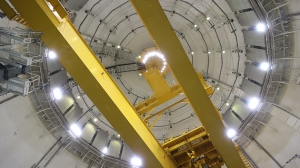Belarus' approach to managing spent nuclear fuel explained

Belarus and Russia have signed an intergovernmental agreement on cooperation in the management of spent nuclear fuel. The document was signed by Belarusian Energy Minister Viktor Karankevich and Director General of the Russian state corporation Rosatom Aleksei Likhachev in Sochi on the sidelines of the international forum Atomexpo 2022. Yelena Artemova, Deputy Director General of the enriched uranium export company AO TENEX explained what the agreement stipulates and what approaches various countries use to handle the problem.
Spent nuclear fuel is generated in the course of normal operation of a nuclear reactor. The general public and regulatory agencies are worried about what happens to the fuel next.
The available options
Yelena Artemova noted: “On the whole, most of the countries stick to the delayed solution concept. Spent fuel is stored for about 60 years at some site in hope that new technologies may be invented and the management of this fuel will become more economical and acceptable.”
Two approaches offer final solutions at the moment. A number of countries prefer burying spent nuclear fuel deep underground. For instance, Finland, Sweden, and a number of other countries opted for deep geological disposal. These countries intend to build geological disposal sites in their territories. The expert noted that such a facility is quite expensive and complicated from the engineering point of view.
A number of countries prefer processing spent nuclear fuel. Russia is one of them. Belarus has also opted for this approach and will cooperate with Rosatom, which offers innovative approaches to spent nuclear fuel processing.
Recycling in detail
Spent fuel can be kept at the nuclear power plant after it has been stored for some time in a cooling pond next to the reactor. Once the fuel is ready for transportation, it will be transported to Russia and processed using existing facilities. Uranium and plutonium will be extracted in the course of processing. These elements can be used in the customer's fuel cycle if the customer is ready for that and wants it. The approach improves the economy of the fuel cycle. Or these elements can be used in the fuel cycle of the Russian Federation, Yelena Artemova explained.
Radioactive waste is generated as part of the process. Experts and the general public are concerned about fate of the waste, too. “At present we prefer fractionating the waste the recycling process produces. Waste will be separated into fractions. We intend to return the short-lived fraction, which activity is determined by cesium and strontium isotopes, to the customer. This fraction will reach the level of activity of uranium ore in 300 years as a result of half-decay. This fraction can be stored close to the earth surface, there is no need for deep geological disposal. It is considerably simpler and cheaper,” the expert noted. The long-lived fraction can be added to fresh fuel and used by fast-neutron reactors.
Arrangements with Belarus
Belarus has passed a national concept on managing spent nuclear fuel that relies on a balanced nuclear fuel cycle principle. “An intergovernmental agreement was signed yesterday. It was done well in advance. The first unit of the Belarusian nuclear power plant has been commissioned, the second one is nearly ready. Spent fuel is stored in cooling ponds near the reactor at the nuclear power plant site. This fuel will require additional procedures at the beginning of the 2030s. This is why we bear this deadline in mind as we work to create the entire regulatory, contractual, and logistic chain in order to prepare the fuel for transportation to Russia,” Yelena Artemova pointed out.
The spent fuel will be processed by the Mayak enterprise in Russia's Chelyabinsk Oblast. There is also an integrated mining and chemical combine, which is about to commission a new plant for processing spent nuclear fuel using innovative technologies. Thus, two plants will be available and there are plans to increase the current processing capacity, the expert said. Once the spent nuclear fuel is processed, Belarus will get back the short-lived fraction of the radioactive waste for subsurface storage using the appropriate infrastructure.
Russia can already reuse reprocessed uranium. Reprocessed plutonium can also be used as fuel for fast reactors and thermal-neutron reactors. “About 97% of the materials a full rod array contains can be recycled and reused as part of the fuel cycle. Such as reprocessed uranium and plutonium. Our technologies allow multiple recycling – up to seven recycling cycles,” Yelena Artemova noted. In her words, the matter can be discussed with Belarusian partners in the future.













